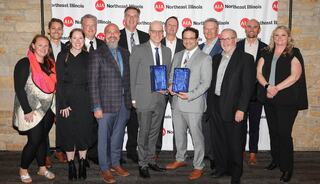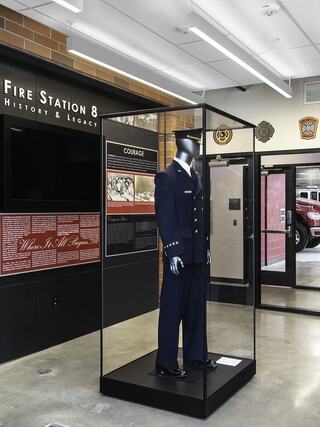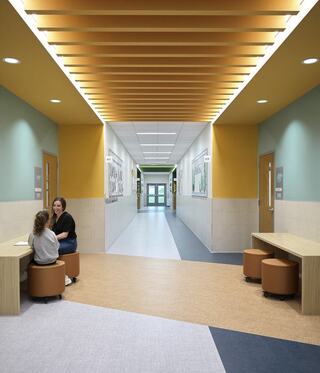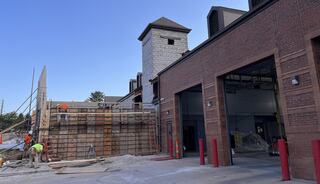
Building Trust, Building Futures for Federal Clients
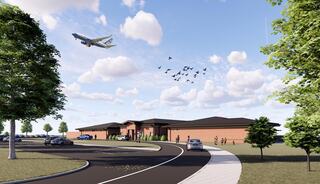
When FGMA Federal Practice Leader Andy Stehl talks about architecture, he doesn’t begin with buildings. He begins with people.
Raised in Smithton, Illinois, Andy’s path into architecture started with a love of drawing and a curiosity for how things worked. A high school drafting program gave him practical skills, and a recruiter from Ranken Technical College opened his eyes to the field. From his first job designing K-12 schools to his current role leading FGMA’s federal practice, Andy has built a career around the idea that architecture is ultimately about service — to students, to communities and now, to people serving in the U.S. military.
From Classrooms to Installations
Andy joined FGMA in 2006, attracted by the firm’s collaborative culture and community-driven portfolio. For the first decade, he focused on schools, fire stations and municipal buildings. These projects taught him how to balance technical requirements with stakeholder engagement, a skill set that would later prove invaluable in federal work.
His transition into the federal sector began in 2016, when FGMA was awarded the Pierce Terrace Elementary School at Fort Jackson in South Carolina. Delivered through a design-build partnership, the project required navigating the strict standards of the Department of Defense Education Activity (DoDEA) and United States Army Corps of Engineers (USACE). The school was designed with flexible classrooms, secure entry points and energy-efficient systems. For Andy, it was an eye-opening introduction to the complexity of federal design.
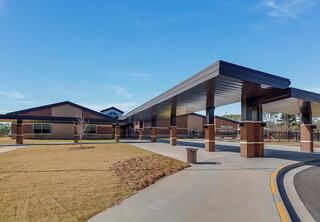
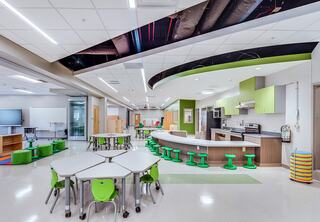
That first project opened the door to a series of commissions across the country. FGMA has since completed barracks at Great Lakes Naval Base & Fort Riley, child development centers in multiple states and a new security campus at Offutt Air Force Base. Collectively, the firm has delivered more than $300 million in federal projects, underscoring its capacity to handle large-scale, high-stakes assignments while maintaining its people-first ethos.
The High Stakes of Federal Design
Federal architecture demands rigor beyond most local projects. Design teams must meet anti-terrorism force protection standards, integrate advanced security systems and comply with a maze of building codes unique to military installations. In design-build projects, contractors and architects commit to scope and cost upfront, leaving little room for error.
“They told us, ‘This has a direct impact on national security,’” Andy recalls. “You realize very quickly this isn’t just another project.”
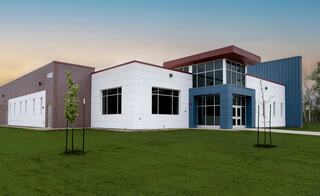
Offutt Air Force Base in Omaha, Nebraska
Similarly, in projects like the Scott Air Force Base Child Development Center in Illinois, success means more than meeting sustainability standards or delivering on schedule. It means providing safe, nurturing spaces for children whose parents may be deployed overseas. “At groundbreaking ceremonies, when you see kids digging with toy shovels while their parents in uniform look on, you understand the responsibility,” Andy says. “We’re designing places that directly support military families through the ups and downs of service.”


Expertise Through Collaboration
One of FGMA’s defining strengths is its collaborative ethos. Federal projects are rarely executed by a single firm; they demand partnerships with contractors, engineers and specialty consultants. Andy has made collaboration the hallmark of FGMA’s federal practice. “We don’t sugarcoat; we don’t oversell,” he says. “We just do the work and support the team.”
This mindset has earned FGMA long-term partnerships. The firm has worked repeatedly with partners like EXP Federal, who value FGMA’s reliability and flexibility. In one instance, FGMA’s team went beyond contractual obligations to help a partner meet a critical deadline, ensuring the project stayed on track. “We don’t need to run the show,” Andy emphasizes. “We’re here to help however we can.”
That spirit of teamwork also extends internally. Andy has built a Federal studio that blends deep technical expertise with a willingness to learn. Younger staff gain exposure to federal standards while contributing fresh ideas from civic and educational work. Andy sees this cross-pollination as vital: “We’re still building our portfolio, but every project makes us stronger and more efficient.”
Designing for Mission, Family and Community
FGMA’s federal portfolio spans a wide spectrum of facility types, from barracks and training centers to schools and wellness facilities. But Andy emphasizes that the common thread is human impact.
Child Development Centers, like those at Wright-Patterson Air Force Base and Scott Air Force Base, provide safe, modern childcare for military families. These centers integrate security requirements with playful, light-filled interiors, reflecting both mission needs and the developmental needs of children.
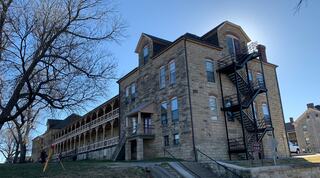
The renovation of Fort Riley’s Historic 1889 Cavalry Barracks at Building 223 transformed the building into updated apartments with additional amenities, balancing efficiency with livability. Natural light and common spaces foster a sense of community for young service members. The renovation preserved the building’s historic character while providing comfortable apartment living.
Community support facilities, such as field houses and wellness centers, draw directly from FGMA’s PK-12 and municipal experience. These spaces support both physical training and quality of life, echoing the firm’s belief that architecture should strengthen both mission readiness and family wellbeing.
Building Futures
Today’s federal projects bring evolving demands: energy efficiency, resilience against climate events and heightened security. FGMA has embraced these challenges as opportunities. At installations in flood-prone regions, designs elevate mechanical systems and use resilient materials. In high-security environments, FGMA integrates standoff distances, secure vehicle circulation and blast-resistant glazing without creating fortress-like atmospheres.
On sustainability, the firm exceeds benchmarks whenever possible. “Best practices should be part of every project, regardless of whether a plaque ends up on the wall,” Andy says.
For Andy, the work is deeply personal. He plays hockey with service members from Scott Air Force Base, only to see some deployed weeks later. “These aren’t just clients,” he reflects. “They’re neighbors, teammates, part of our community.” That closeness keeps FGMA’s mission clear: to design facilities that protect, nurture and empower those who serve.
Under Andy Stehl’s leadership, FGMA’s federal practice has grown from a single DoDEA school into a portfolio of projects across the nation. The firm approaches each commission with humility, adaptability and the belief that collaboration creates better outcomes.
“We’re not a winner-take-all firm,” Andy says. “We believe in true partnerships — with clients, with contractors, with communities. At the end of the day, we’re here to provide quality design that supports the men and women who serve.”
FGMA’s mission is clear: design is never just about buildings; it's about creating purposeful environments that nurture communities and lay the foundation for a strong future.
News & Insights
All Articles
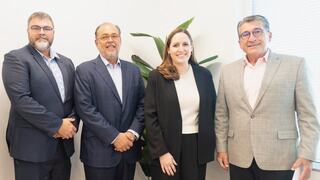
St. Louis PK-12 Leader Emily Spindler Shares Insights on the Future of Ed Spaces
